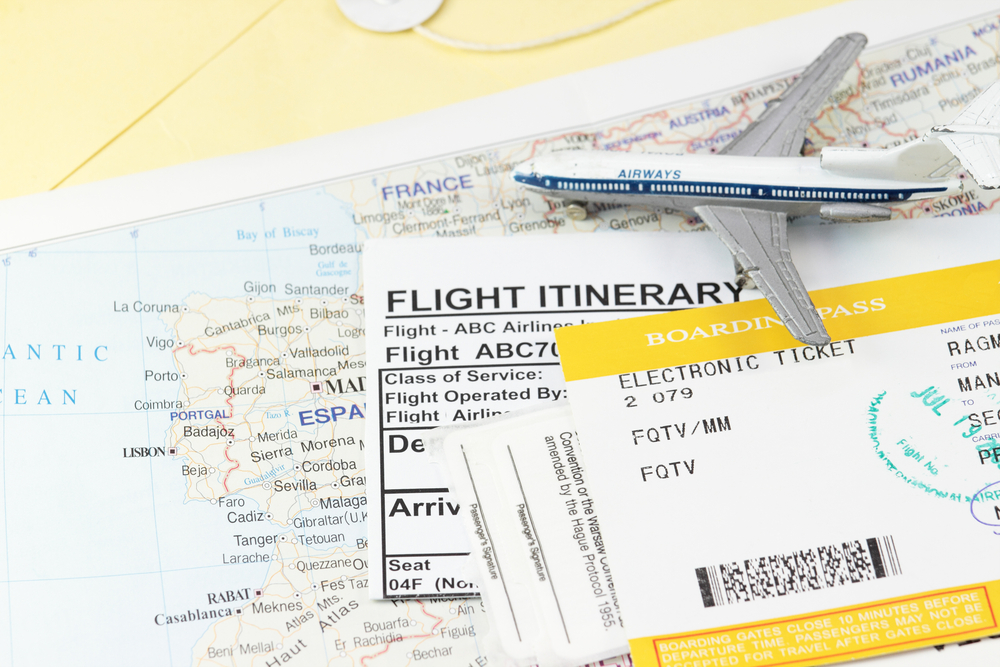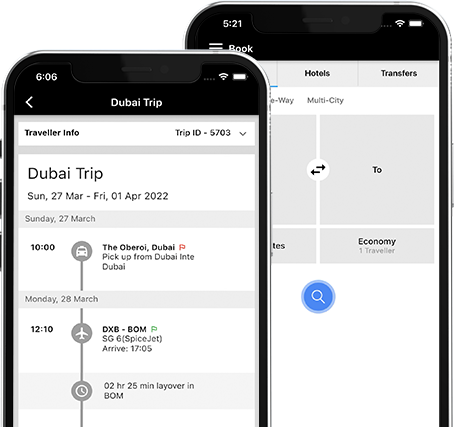Business travel involves multiple variables like modes of transportation, airport transfers, local transportation, hotel bookings with check-in and check-out times, etc. Hence, to effectively manage the travel requirements and stay on schedule, a well-thought itinerary is highly essential.
A business trip itinerary with meeting schedule includes a journey plan between multiple destinations and event timings to mitigate the complexity of the travel. The employee is better positioned to focus on the business objective of the travel instead of struggling to make last-minute plans or search for critical travel-related information in an unfamiliar location.
An organization’s business travel itinerary must comply with the travel policy. Integrating travel guidelines and cost control measures into a travel itinerary is challenging. Corporate travel managers and TMCs prefer app-based travel management platforms to allow employees the freedom to create travel itineraries. It streamlines the travel management functions without deviating from the travel policy.
Types of business travel itinerary

Business travel itineraries serve specific business purposes. Through travel itineraries, company employees effectively achieve multiple goals, like sales, services, conferences, training programs, and trade fairs. There are few types of itineraries depending upon the goal of the travel. The following are a few examples of travel itineraries and highlights about how to create these.
1. Field sales itinerary
Business itineraries for sales executives need an in-depth knowledge of the availability of customers. It is better to fix prior appointments to avoid hassles. A field sales executive should plan an itinerary for an entire month. One must have leeway for making changes if there are unexpected events, like cancellation of appointments or any hotel and flight bookings. Sales executives like to have the flexibility to change the plan if a particular sales meeting lasts longer than expected. There should be a sufficient time gap between two sales appointments to facilitate extra time for meetings and traffic issues.
A SaaS-based travel management platform like Paxes allows employees the flexibility of modifying the itinerary to incorporate changes.
The itinerary of sales executives must outline transportation details between destinations. Providing an option to Plan B if the original plan does not work out.
2. Events and conferences itinerary
Trade conferences and exhibitions are crucial for establishing the organization’s visibility, networking, and knowledge sharing. Most trade events and conferences offer the opportunity to attend sessions by subject experts. The business trip itinerary with meeting schedule requires surgical precision to maximize the benefits of the sessions and meetings. One can visit the exhibition during breaks between the two sessions.
The itinerary for business meetings should provide details of transport facilities and contact numbers of local travel agents. The hotel address for the stay during the conference is essential with the date and time of checking in and checking out.
3. International business trip itinerary
The international travel itinerary empowers the business executive with adequate knowledge about the destination countries and ways to navigate and communicate without hassles during business trips.
Travel details like flight schedules, airport transfers, and local transport are crucial while constructing an itinerary for international business travel. Employees should also know about places to eat and information about local culture. Knowledge of all local public transport options will help the international business traveler choose an appropriate mode like cabs, tube, metro, or bus. Printouts of relevant maps are helpful as a reference if there are issues with the mobile network.
Suggested Read: Basic Guidelines For International Business Travelers
How to create business travel itinerary

Constructing a business travel itinerary that matches employees’ preferences for travel and accommodation is crucial for a satisfying and productive business trip. The business travel itinerary should have each detail that an employee may require during the business trip.
The itinerary should be easily accessible to the employee and managers. Creating an itinerary using a travel management platform allows easy access to all stakeholders, including employees, line managers, corporate travel managers, HR executives, and finance executives.
The itinerary’s compliance with the travel policy of the organization is mandatory. Corporate travel managers and TMCs should design a relevant template for constructing an itinerary that incorporates the specific travel policy guidelines.
Enabling employees to create their travel itineraries through SaaS-based travel apps and platforms ensures freedom of choosing the mode of transport, airline, and accommodation. These platforms help corporate travel managers and TMCs integrate a company’s travel policy to avoid deviations. Employees have seamless access to several travel options because of the massive inventories of hotels, LCCs, and SOTO options.
Steps to create business travel itinerary
Step 1: Create business trip purpose as per the requirement of the company
The primary step to any itinerary is to figure out the objectives and purpose of the activity. One should clearly define the success of business travel and document the key goals.
Step 2: Find the best transport and accommodations
Research the transportation option that will be the right fit for the employee and adhere to the budget of the company. You can use platforms such as Paxes to compare prices and amenities of the transport. Additionally, you should find the accommodation option that is near to the event and meeting venues.
Step 3: Arrange venues for meeting and social gathering
As your brand’s name is on stake, ensure that the meeting venues are top-notch. However, arranging nothing less than the best cost money. Therefore, you should establish a balance between cost and amenities.
Step 4: Consolidate contact information
You should create a list of contacts that are necessary for the smooth trip. Ensure to share the information to each member of the trip for easy accessibility.
Business travel itinerary pro-tips
- Schedule downtime strategically to prevent burnout and plan leisure activities during free time
- Utilize expense management apps to track spending in real-time and capture digital receipts
- Set up communication channels with colleagues; share live location for safety
- Research health guidelines for the destination and carry a basic first aid kit
- Bring necessary chargers, adapters, and power banks for technology needs
- Anticipate disruptions and have backup plans for meetings and alternative transportation
- Reflect on the trip’s success and challenges; collect feedback and document insights
What should business travel itinerary include
The following are key considerations while creating a business travel itinerary:
- Thorough information about transportation and staying arrangements in each segment of the business trip
- Total travel time with a time of departure and arrival
- Flight details like carrier and PNR
- Hotel check-in and check-out time
- Contact details of hotel reception and transport staff
- Details of meeting schedules
- Phone numbers of business contacts
- Venue address of business conference or trade expo
- Gate passes with breakfast, lunch, and banquet coupons for conferences
- Specifics of a business meeting, objectives, and contact numbers of local dealers
A business travel itinerary should be a one-stop reference source to know every minute detail of destination location, local transportation, to-and-fro travel, and accommodation. It should include schedules of programs and business meetings.
Benefits of business travel itinerary
The business travel itinerary facilitates a smooth business trip for employees. It helps improve the traveling experience and the productivity of the business trip.
The itinerary is a crucial outline of the business trip as it significantly eliminates the uncertainty of travel and accommodation. Employees know where to stay and whom to meet with precise appointment schedules by referring to the business itinerary. Further, it helps an employee know better about packing list for business travel. An ideal business travel itinerary considers business travelers’ priorities, like preferences for transportation and accommodation. It looks into the food choices of the employee to facilitate a smooth traveling experience.
Prioritization of the various business objectives is a crucial advantage of a business travel itinerary. It aims to provide sufficient time to the employee between arrival at the hotel and the first point of the business trip’s agenda. The employee can also get enough time to prepare if they are going to deliver a sales presentation.
Business travel itinerary template
General Information
Traveler’s name:
Purpose of trip:
Travel dates:
Destination:
Travel Details:
Flight: [Flight Details – Departure Time, Flight Number, Airline] Hotel: [Hotel Name, Address, Contact Information] Ground Transportation: [Transportation Details – Rental Car, Shuttle Service, etc.] Schedule:
Day 1: [Date]
Activity 1: [Start Time – End Time] Activity 2: [Start Time – End Time] Activity 3: [Start Time – End Time] Activity 4: [Start Time – End Time]
Day 2: [Date]
Activity 1: [Start Time – End Time] Activity 2: [Start Time – End Time] Activity 3: [Start Time – End Time] Activity 4: [Start Time – End Time]
And so on…
Traveler: [Name], [Phone Number], [Email] Emergency Contact: [Name], [Phone Number] Notes:
[Additional Notes, Special Instructions, etc.]Common travel itinerary pitfalls to avoid
- Tight schedule and too many itinerary can be exhausting and drain employees energy
- Neglecting time zone differences can result in missed flights or meetings
- Selecting accommodations based solely on cost without considering proximity to meeting venues or safety can reduce productivity
- Failing to anticipate and plan for potential disruptions, such as flight delays or venue changes
- Detailed records of expenses during the trip can complicate reimbursement and financial reporting
Conclusion
Thorough planning is critical for the success of any business activity, including business travel. The business travel itinerary is an important aspect of business travel as it provides every piece of essential information to the business traveler. Paxes is an established travel management solution to simplify the construction and implementation of a business travel itinerary. It integrates the company’s travel policy, promising strict compliance, and offers an app feature to grant autonomy to employees for creating or changing business travel itineraries.
Business Travel Itinerary FAQs
What does a business travel itinerary include?
A business travel itinerary is a plan used for business travel. The business travel itinerary includes information on travel requirements, necessities, and booking information for all the hotels, flights, and transportation.
What is a field sales itinerary?
A field sales itinerary is where the employee goes out from their regular office setting to make sales outside of the office. The field sales itinerary helps map out the necessary locations for travel, along with the specific requirements and arrangements that are made for the trip.
Who should create the business travel itinerary?
The travel management company and travel managers are responsible for creating a travel itinerary for the employee that includes all necessary information about the employee business trip.
What is a conference and event itinerary?
An event or conference itinerary is a plan or schedule of a specific event that includes all of the important dates, events, and their location or timing.
What is an international business trip itinerary?
An international business trip itinerary is a schedule made when an employee travels out of the country for business. The international business itinerary includes international information such as foreign laws, visas, and travel information for an efficient and hassle-free trip.
What is a business travel itinerary?
A business travel itinerary is a plan that outlines the essential detials such as flights, accommodation, etc. of any corporate trip.
How do I make a professional travel itinerary?
For a good business trip itinerary, one should be aware of the price lists of various suppliers such as flights and accommodations. Also, one must ensure that everything is planned to save time of the traveler without overloading them with work
What is a travel itinerary format?
A travel itinerary format defines the wireframe for the itinerary planning. It can include travel details, documents required, events timings, etc.
What is a business travel itinerary?
A business travel itinerary is a complete document that sketches out the schedule and details of various business trips. It generally includes the flight and railway tickets & dates, booking accommodations, event details, etc.
Why is a travel itinerary important for business travelers?
A travel itinerary is crucial for business travelers for several reasons such as organization and efficiency, time management, cost control, and emergency preparedness.
Should I include specific travel and accommodation details in the itinerary?
Should I share my travel itinerary with colleagues or supervisors?
What are some common mistakes to avoid when creating a business travel itinerary?
When creating a business travel itinerary, avoid the following common mistakes such as overpacking the schedule, failing to include backup plans, not factoring in travel time, ignoring local customs and holidays, and forgetting to include contact information.
How can I optimize my travel itinerary to minimize travel time and maximize productivity?
To optimize your travel itinerary, consider the tips- centralize meetings, use productive travel options, prioritize important meetings, group similar activities, leverage technology, flexible scheduling, etc.



